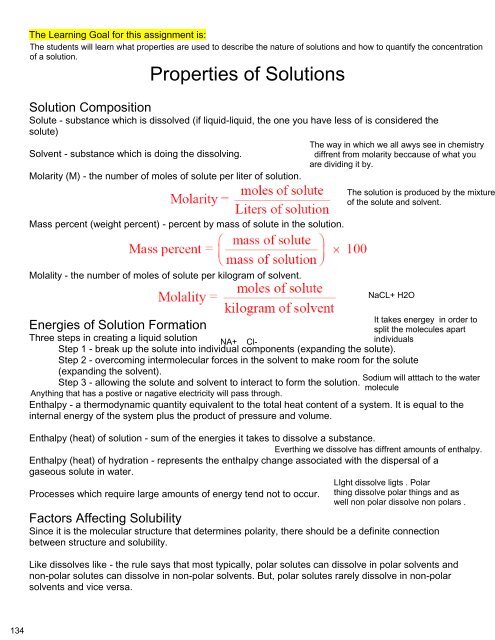Create successful ePaper yourself
Turn your PDF publications into a flip-book with our unique Google optimized e-Paper software.
dissolved in water. All electrolytes conduct an electric charge at different degrees. They are different<br />
types of electrolytes such as weak and strong. Strong electrolytes 9 are solutions which are nearly all<br />
of the solutes exist as ions. ON the other hand Weak electrolytes 10 conduct a very poor electric<br />
current due to the fact there is only a fraction of the solute in the solution which exist ions. Most<br />
important they are vital to metabolic process which are used to carry electrical impulses internally to<br />
other cells. Which are crucial to the nerves and the function of the muscles,<br />
Hydrates<br />
The water in which a crystal is contained in is referred to as a water of hydration 11 or water of<br />
crystallization. Different types of compounds have /contain water hydration in which is a hydrate 12 . As<br />
I stated before the crystal, is referred to as water of hydration it can be heated above 100 Celsius in<br />
which they lose their water of hydration. Furthermore the forces that are keeping the water molecules<br />
intact in hydrates aren’t very strong, so the water is easily lost or regained. Some hydrates contain<br />
water but some don’t. For example the substance anhydrous 13 does not contain water. There is<br />
different types of hydrates such as Efflorescent and hygroscopic Hydrates. Efflorescent hydrates is<br />
when the water molecules in hydrate are held by weak forces so the hydrates often have a good<br />
amount of vapor pressure. If it has a vapor pressure higher than the pressure of water vapor the<br />
hydrate will lose its water of hydration of effloresce 14 . While Hygroscopic hydrates have a low vapor<br />
pressure where the water is removed from the air to create a higher hydrate. The hydrates and the<br />
other compound which remove moisture from the air are referred to as hygroscopic 15 . An example of<br />
this would be calcium chloride which absorbs a second, molecule of water. It is also used a<br />
desiccant 16 which is a substance used to absorb moisture from the air and create a dry atmosphere.<br />
Similar to this would be a deliquescent 17 which means that they remo0ve sufficient water from the air<br />
to dissolve completely and form a solution,<br />
15.3 Heterogeneous Aqueous Systems<br />
Suspensions<br />
Heterogeneous mixtures are not solutions. For example a suspension 18 is a mixture from which<br />
particles settle out upon standing. Suspension are different from a solution because the particles of a<br />
suspensions are much large and don not stay suspended indefinitely. Particles have an average<br />
diameter greater that then 1000 nm. Suspension are heterogeneous due to the ACT that 2 substance<br />
can clearly be identified. Gelatin is an example of a mixture called a colloid.<br />
Colloids<br />
A colloid 19 is a heterogeneous mixture containing particles that range in size from 1nm to 1000 nm.<br />
The particles spread or disperse. Many colloids are cloudy and milky in appearance similar to<br />
suspension when they are concentrated. They can also look clear or almost clear like solutions when<br />
they are dilute. The important difference between colloids and solutions and suspensions is in the<br />
size of the particles. Colloids have particles smaller than the ones in suspension and larger than<br />
those in solution. Colloids have different things they cause such as effects, put things in motion. The<br />
tidal effect is one of these ordinarily you cannot see a beam of sunlight unless they pass through<br />
particles of water or dust sand sir. The reason why it’s visible is because they scatter the sunlight.<br />
The scattering of the visible light by colloidal particles is called the Tyndall effect 20 . While some are<br />
seen by sunlight other thing get studied in different ways. Such as flashes of lights or scintillations are<br />
seen when colloid are studied in microscopes. The chaotic movement of the colloids is which was first<br />
studied by brown a botanist which was later named Brownian motion 21 . Mayonnaise is an example<br />
of a colloidal system called an emulsion, an emulsion 22 is a colloidal dispersion of a liquid in a liquid.<br />
131



